#pentax dslr camera
Explore tagged Tumblr posts
Text
Kodak PixPro Friendly Zoom FZ45-BK 16MP Digital Camera with 4X Optical Zoom 27mm Wide Angle and 2.7" LCD Screen (Black)
Introducing the FZ45, the friendly zoom model from the KODAK PIXPRO collection of digital cameras. Compact, intuitive and oh so easy to use, the FZ45 is the perfect camera for wherever you go. One-touch video, red-eye removal, face detection and convenient AA batteries are just the beginning. Kodak PixPro Digital Camera – Tell your story. 4x optical zoom16MP CMOS sensor1080p full HD video27mm…
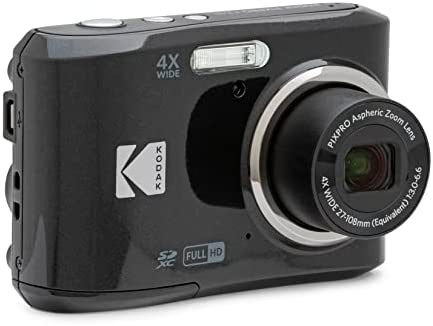
View On WordPress
#canon dslr#digital camera#dslr camera#Mirrorless DSLR Camera#nikon dslr#pentax dslr camera#sony dslr
0 notes
Text

#coffee#coffeetime#coffeelovers#frenchpress#bialetti#camera#dslr#pentax#filmphotography#filmisnotdead#shotonfilm#fujifilm#superiaxtra400#yashica#yashicaelectro35#yashicaelectro35gsn
2 notes
·
View notes
Text
Ughhhhhhh...I know i shouldn't buy a Pentax 645z, but GOSH, I want one.
0 notes
Text
Pentax K-5 Review
Introduction For grins and giggles, the local camera store still had the Pentax K-5, so I decided to take in a little trade and snag it to, comparing it against the K-3 we got just a few months ago. It was a decent price and included the battery grip. A lot of this review will echo the K-3 review, as they are not that far off. Images processed for this review were done to my desires on how I…

View On WordPress
0 notes
Note
Is the Pentax KS-2 a decent camera for getting into DSLR photography? I like the look of it for the weather sealing because it's always raining round here (normal island), plus it's around the right level of price and features if buying used.
I’ve never used one but I’ve only ever heard good things about Pentaxes in general
11 notes
·
View notes
Note
Can you please ask Brian what camera, lens and film he uses to shoot the eclipse?
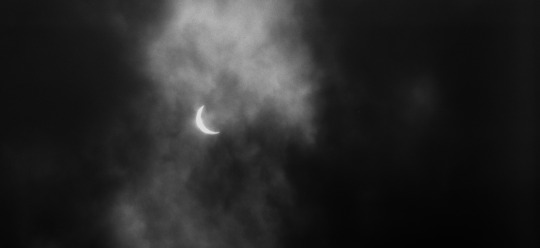
This is a characteristically late response, but I'd love to get into it. I got into film photography by picking my dad's childhood brownie hawkeye off of a shelf and ever since then i've stayed pretty cheap with the hobby. I got a really good deal on a Kiev-80 a couple years ago. For those who don't know, its a 50 year old soviet camera made as an imitation of a Hasselblad (the camera we took to the moon). It's a medium format camera, so focal lengths work a little different than they do in 35mm
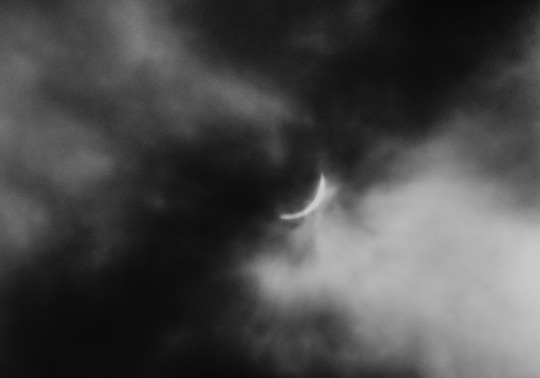
Medium format cameras like this take pictures that are 60mm by 60mm. Your typical 35mm camera takes 36mm by 24mm frames, so the added film sixe here means generally everything has to get bigger. The lenses i've gotten for this camera all have massive cases and can be carried with their own separate strap. The lens used for the eclipse is just... so big. oh my god. it's a mess. It's a Tair-33, with a minimum f stop of 4.5 and a focal length of 300mm (equivalent to 165mm on 35)
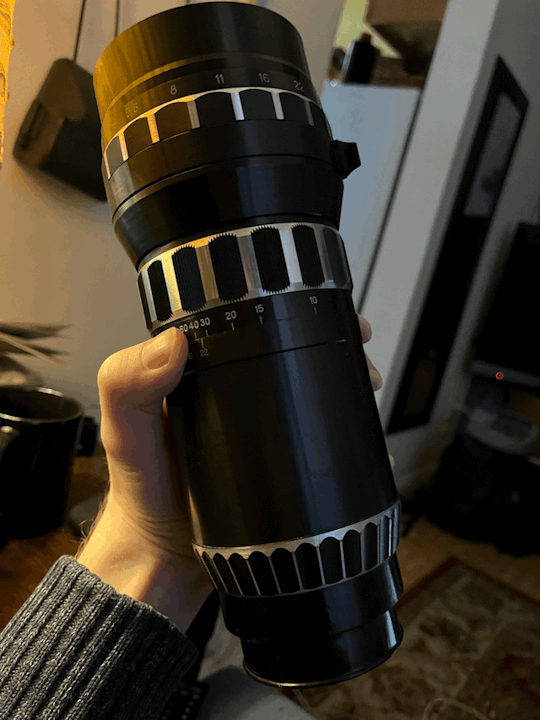
This model of the lens has very fun, characteristic stripes, the aperture control is all the way at the front, and easy to use. Focusing, however is slow, as the weight of everything creates quite a bit of friction. You can get one of these for about $80 bucks. Now 300mm here is not a great magnifier, so I also got a (faulty) accessory to extend the focus, bringing the lens to 600mm (330mm equivalent in 35). It also makes this camera, all put together, into The Largest Object of All Time.

squash and butter for scale
To see the difference between 300mm and 600mm, check out these photos of the regular, non-eclipsed sun at both lengths
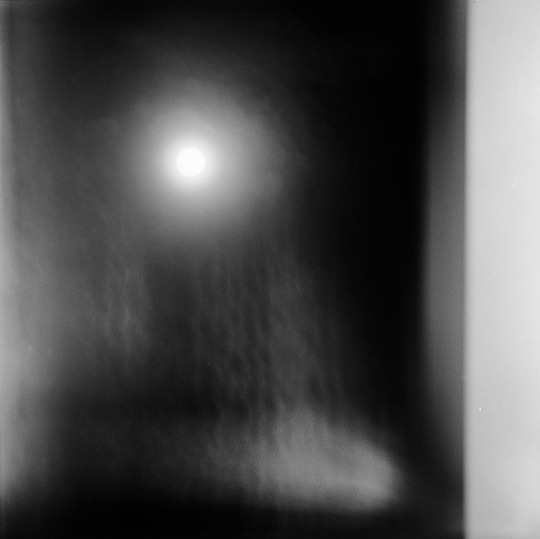
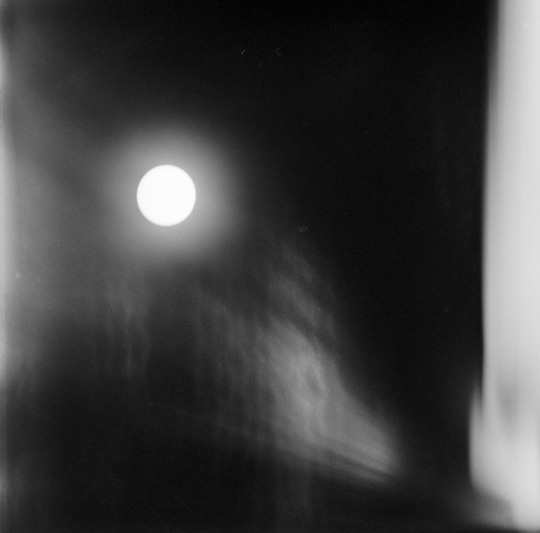
You're probably wondering why these pictures look so weird. these lenses are don't have very effective coatings. you wouldn't believe the processes that go into coating your glasses, your camera lenses, your phone lenses. The easiest kind of picture to take is one where your subject is lit by a souce that is behind the photographer. things get complicated with backlight, creating ghosting and glare as seen above. the light bounces between the glass elements (and the dark filter used to photograph the sun is also glass, complicating it further). taking a direct photo of a light (especially the fucking SUN) leads to some pretty crazy unpredictable variables.
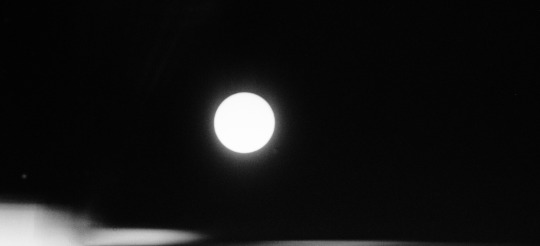
My camera has recently taken on a new malady too, where at low speeds, the shutter (which in this camera is a huge metal curtain sticks at the edge without totally closing. It causes these stripes at the edge of the picture. This can be frustrating if i forget, but I like having the issue. If i want a picture to look normal, to plan it out, to totally control it, I have a digital camera for that. I got into this film stuff for the eccentricities.
For the regular sun photos, I think I was shooting on Ilford FP4, which i think i stand developed in rodinal. At the eclipse, I only got through one roll of film, becasue the cloud cover was brutal, but i took those pictures on Kodak Tri-x 400 (developed normally in D-76). I did it all in Black and white because, in general, b&w negatives are pretty generous with mistakes. All the guides i could fine for solar photography were understandably written with digital cameras in mind, so I couldn't be totally sure about my math (as the camera is totally manual) or even my eye safety (as I'm using a viewfinder; my vision seems fine a month later)
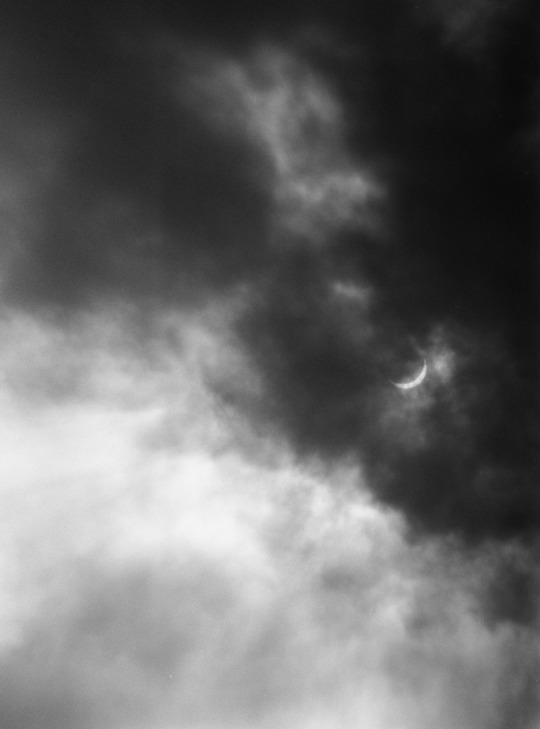
the actual iris on this lens is right up in front. Tightening the aperture, especially when the extender is attached, leads to a vignetting issue, turning your pictures into a circle
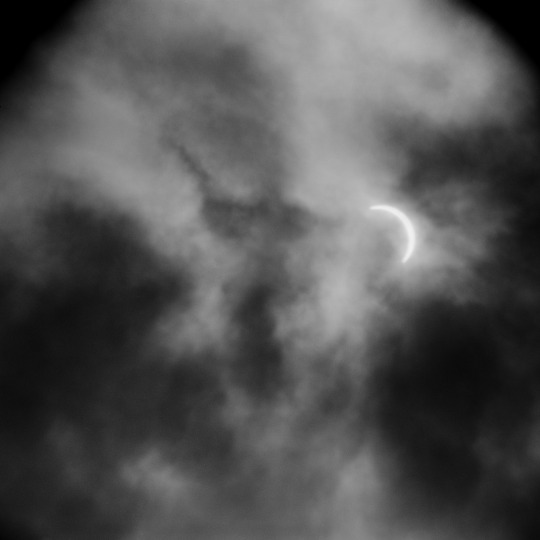
once totality hits, the light changes dramatically. you can stare straght at it without glasses and not have to worry about damaging your eyes for those short minutes. so i didn't even bother with film at that stage. I just pulled out my DSLR with a cheap 500mm Samyang mirror lens made for pentax. It's very compact and very, VERY shitty. Shallow focus, really dark, ugly out-of-focus elements, focuses past inifinity, i love it. only got a couple pictures that way, and then put the camera down and enjoyed the experience
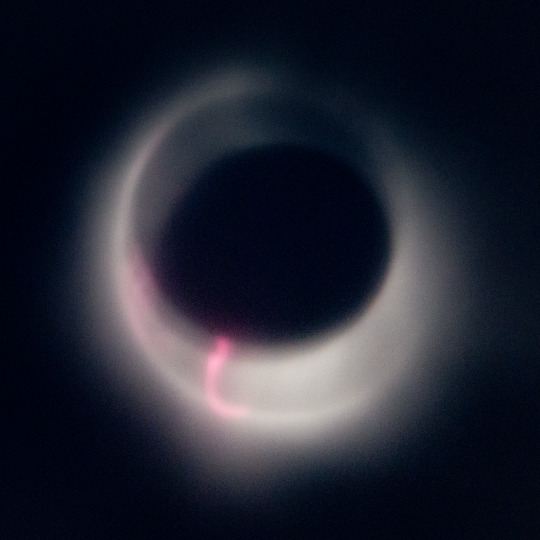
#film photography#medium format#120 film#soviet cameras#black and white#solar eclipse#solar photography#ilford
10 notes
·
View notes
Text
I suppose I ought to introduce myself
I like taking photos with odd cameras. I am by no means a professional. I just have loads of cameras I've picked up second hand from various places, and like mucking about with them in different ways.
Right off the bat, I don't care about taking the perfect shot. That's boring to me. While I don't go out with the goal of intentionally taking wonky shots – I do actually try to make sure each shot is focused and exposed properly – quite a lot of my cameras are broken or weird in some way. My main film camera technically works, in that the lens attached to it is in good nick, and when I push the shutter button, it goes click. But the shutter fires inconsistently, and will often misfire at the lightest touch, it doesn't really fire at the speeds it's set to, the ISO dial is loose as hell and is always changing itself, and even if it wasn't doing that, the light meter really has no idea what light is in the first place.
It really only gets better from here. All of my cameras have some sort of physical malady by dint of being second hand, and in many cases, straight up antique, or because they're Holgas and have a deliberately imperfect design. I've got a couple of "toy cameras" as well, with cheap plastic lenses that make any given shot look a bit weird. None of these categories are mutually exclusive either.
But I also just like to do terrible things to both my cameras and the film I shoot on. My favourite thing to do is shove the wrong format film into the cameras. Sometimes I don't feel like cutting down film to fit into my 127 cameras, so I'll cram a 35mm roll in there. Or I'll stick one into one of my 120 or 620 cameras just for the hell of it. I like to redscale film, soup it, and just generally fuck it up before and after shooting. When I develop the film here at home, I don't put a lot of attention into making sure everything is perfect down to the tenth of a degree and to the second. I am not that fussed about any of it, frankly. As long as the roll comes out of the tank with photos on it, I'm happy. If they're messed up, whatever. That's part of the fun.
Right now, I'm slowly working through uploading my backlog over here. I've got even more photos on deviantART, and I post them to Patreon a month before I put them anywhere else. I also try to remember to put prints up, but that's a whole process on its own. In addition to uploading my backlog, I've been spending much of my time just working on scanning and editing a whole other backlog of negatives.
And according to Lightroom, right now that comes down to nearly 400 photos that I've yet to post, and a further 5,000-odd that I've not even looked at for editing. Plus the five or six rolls sitting on my printer waiting to be scanned.
You'll find a mix of birdwatching and urban photography, along with some random other things. I have favourite subjects I like to go back to again and again, and you'll get used to seeing them through a variety of lenses.
TL;DR, I take a lot of photos, many of them odd or wonky, and I'm never going to be done with this backlog. And the photos I have in Lightroom are only from the last few years. Multiple hard drive crashes have caused me to lose all of my digital photos a few times over.
Current Gear:
Canon EOS Elan II E (35mm)
Canon EOS Rebel XT (dSLR)
Fujifilm Instax Mini 90 (instant film)
Holga 135BC (35mm)
Holga 120 WPC Panoramic Pinhole (120)
Kodak Jiffy Six-20 (620)
Kodak Brownie Target Six-20 (620)
Kodak Brownie Starmatic II (127)
Kodak Brownie Starflex (127)
Kodak Ektar H35 (35mm)
Kodak Ektar H35N (35mm)
Minolta Maxxum 3000i (35mm)
Minolta Maxxum 8000i (35mm)
Pentax MG (35mm)
Ricoh KR-5 Super II (35mm)
Sawyer's Nomad 620 (120/620)
Super Ricohflex (120/127/35mm)
Plus photos from a variety of iPhones
4 notes
·
View notes
Text
Pentax 645Z Review
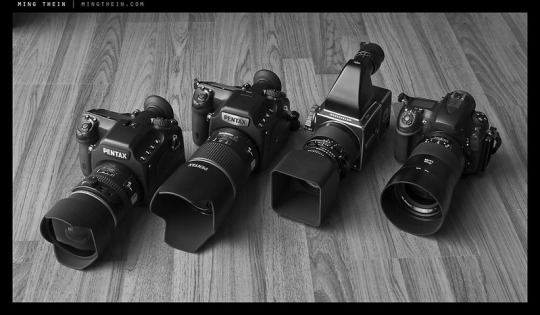
Medium-format cameras offer truly spectacular resolution, but until now, it's always come best camera alongside a difficult compromise. With the Pentax 645Z, that changes. Building on 2010's 645D, the Pentax 645Z offers features that are rare or in some cases unique in a medium-format camera. Pick up its weather-sealed body, and you'll find both live view and video capture on offer, not to mention an extremely wide sensitivity range, 27-point phase-detect autofocus system -- and compared to rivals, very swift performance too! And of course, you'll get the incredible detail-gathering capability of medium-format, plus a really big, bright viewfinder. Is it time you considered moving up from full-frame? Read on and find out!
Pros Phenomenal resolution and detail; Great high ISO performance; Rugged, weather-sealed body; Huge, bright viewfinder; Fast autofocus works well in low light; Swift performance for a medium-format camera; Good battery life; Shoots Full HD video
Cons Quite bulky compared to an APS-C or full-frame DSLR; Autofocus points clustered near center of frame; Most lenses aren't weather-sealed or optimized for digital; Prone to aliasing artifacts (but so are most high-end cameras these days); Attracts a lot of attention from passers-by
Price and availability Available since June 2014, the Pentax 645Z is priced at US$8,500 body-only.
Back in early 2010, Pentax launched the 645D, a medium-format digital SLR that it had been developing for the previous five years. It might have been a long time coming, but it was nonetheless exciting for it. The 645D leapfrogged rivals Canon, Nikon and Sony with two-thirds greater sensor area than a full-frame sensor, yielding a unique look and shallower depth of field. At the same time, it was vastly more affordable than offerings from medium-format makers like Hasselblad and Phase One, yet rugged enough to be used in the field.
Pentax 645Z Review -- Front view with lens The reason Pentax -- since taken over by Ricoh -- could offer its camera at a more attractive price-point than other medium-format products was pretty simple. Much of the design work for the 645D could be shared with the company's mass market, APS-C DSLRs, where Hasselblad and Phase One -- neither of which sells consumer SLRs -- had to bear the entire cost of development solely with their medium format products.
While Pentax lacked (and indeed, still lacks) a full-frame DSLR, the 645D served both as an aspirational model for the enthusiasts to look up to, and as something genuinely different to attract pros for whom that resolution and medium-format look was more important than high-speed capture. And boy, did it ever offer a lot of resolution by 2010 standards. (In fact, it's only recently that we've started to see cameras with smaller sensors catching up.) When we first put the 645D in our lab, we were amazed to find that it picked up details we'd never even noticed in our test scenes -- details that we couldn't even see with our own eyes, until we pulled out a magnifying glass to confirm them.
Pentax 645Z Review -- Weather seals Just like the medium-format film cameras in whose footsteps it followed, the 645D was never going to be a mass-market camera. Medium-format is an even smaller niche than it was in the film days, but the 645D was nonetheless a very important camera for the company, and its followup -- the Pentax 645Z -- is no less important.
Just like its predecessor, the Pentax 645Z shares much with Ricoh's flagship APS-C DSLRs -- and with four years of development having taken place on the APS-C front since the 645D was launched, there was no shortage of new features for it to inherit. But the most important feature of them all is at its very heart, a brand-new, Sony-sourced 51-megapixel CMOS image sensor. It's coupled to a PRIME III image processor, as first seen in the K-3, and the 645Z also inherits that camera's 27-point SAFOX 11 autofocus and 86,000 pixel RGB metering systems.
The 645Z's new image sensor allows a spectacularly wide sensitivity range, especially by medium-format camera standards, covering everything up to ISO 204,800 equivalent. It also provides both live view and Full HD movie capture capabilities, neither of which its predecessor was capable of. And performance has taken a big step forwards, at least compared to other medium-format cameras. This still isn't a sports shooter, but it'll shoot at almost triple the speed of the 645D. You'll also be able to review photos post-capture in less than half the time.
2 notes
·
View notes
Text

Yesterday morning, I did the short walk with the dogs... it was cold and overcast but bright. The weather was supposed to be wet all afternoon so I decided to take advantage of the lighting conditions and take the cameras for a quick shoot, I was still packed from the last outing that didn't pan out, so it was quick, but this time I also grabbed the DSLR and a ridicules lens, the 150-600. My go to lens is my 100mm Macro, but decided to make a change, so in the back seat was a Pentax K1000, Speed Graphic, and a pinhole camera and a Conon 5DmkIII with a 150-600... and of course a tripod, loupe & light meter...I setup at the dam 1st and shot one expose with the speed graphic and one with the pinhole... SO... the pinhole, is a birch box and the paper said it was a f426. I downloaded a sheet of paper that I could take a meter reading at f64 and convert it to the f426... so my exposer was to be 2 min. 38 sec... no problem... but wait, I am using film and there will be reciprocity. I don't have internet where I am, I saw a video and they just doubled the time... so that what I did... we will see. I went to the next location just down the road a little more. I had seen a rack of kayaks and canoes, and thought they would be nice... I setup the speed graphic grabbed the light meter and nothing, batteries died, got another set from the truck and they died too, thinking the meter hates the cold maybe or I just can't use rechargeable batteries in the meter. SO wild ass guess... not really, the light didn't change that much... or course as I am typing this I could have used the canon, duh. took the photo. Turned around to see what else I could shoot, the lake and mountain, setup the pinhole... again same timing almost 5 min. as I am watching the timer I catch movement above the water, a Juvenile bald eagle... run to the truck and grab the canon and long lens... no way I can hand hold this so I watch and wait but the time the timer went off the Eagle was no where in sight. I put all the gear away accept for the tripod and canon and walked over and too the above photo, I really hope that the film turns out, I think this will be nice in analog black and white... the end.
PS. Thank you all for reading my meanderings, the reblogs and the comments do make me feel good. I do hope my posts don't come off as me complaining, they really are just the thoughts that are jumbled in my head and sometime I take the time to type them out. CHEERS!
#elementoftheeye#chambersburg#original photography#wordvomit#original photograph#original photographer
7 notes
·
View notes
Text
The Art of Capturing Meteorites’ Mineral Mosaics
Neil Buckland uses a DIY microscopic camera system to create monolithic images that reveal the tiny elemental details of extraterrestrial rocks.
— By Ramin Skibba | Science | April 17, 2023 | Wired.Com

For meteorites rich in the mineral olivine like this one, Buckland's photographs bring out greens, oranges, and blues. Photograph By Neil Buckland
When Neil Buckland, an artist based in Seattle, met a geologist named Tony Irving a few years ago, he had no idea it would launch an extraterrestrial collaboration. Buckland was at the University of Washington photographing ultrathin slices of meteorite for a project Irving was working on. The cut space rocks didn’t seem particularly exciting at first. Then Buckland peered at the 30-micron-thick samples through a pair of polarizing filters. He was stunned by the vibrant collage of hues.

Found by hunters in Algeria after a fireball event in 2013, this meteorite displays the blues and greens of pyroxene, a mineral typically found in volcanic areas. Photograph By Neil Buckland

Meteorites typically have distinct compositions that let researchers attribute them to particular impact events. This rock, determined to originate on Mars, fell on India in 1865. Photograph By Neil Buckland

The grays and whites indicate this meteorite is high in calcium. It’s most likely a shard of the moon broken off by an asteroid eons ago. Photograph By Neil Buckland

Some meteorites, such as this one found in Morocco, show signs of their fall and impact on Earth. The outer layer melts while hurtling through the atmosphere, then solidifies to glass. Photograph By Neil Buckland
Inspired by the photographic possibilities, Buckland went back to his studio and got to work designing a camera system built around a microscope lens attached to a Pentax DSLR. To create his images, he captures a 2-millimeter-square section of a sample at up to 40,000X magnification, then moves the camera slightly and shoots another square. After capturing 300 to 400 of those, he stitches them all together into a photo that can be displayed at up to 12 feet wide. “It’s like a cosmos in a pebble,” Buckland says. “From an artistic standpoint, I try to show the images as big as I do and as detailed as they are to create that existential shift in perspective.”
The polarized light can reveal different minerals within the samples. If a meteorite is rich in olivine, like the one at the top of this article, the light brings out greens, oranges, and blues. For scientists, the configuration of minerals can hold clues to a meteorite’s origins, such as whether it came from an asteroid collision a billion years ago or was ejected from a massive impact on another world with a particular mixture of atmospheric gases. They’re also great to look at if you just want to space out.
4 notes
·
View notes
Text
Nikon COOLPIX P530 16.1 MP CMOS Digital Camera with 42x Zoom NIKKOR Lens and Full HD 1080p Video (Black)
Nikon COOLPIX P530 16.1 MP CMOS Digital Camera with 42x Zoom NIKKOR Lens and Full HD 1080p Video (Black)
Game-changing zoom power in an advanced, easy-to-manage package. Zoom in with the incredible power of 42x optical zoom and capture sharp close-up photos and Full HD 1080p video, then get up close with 84x Dynamic Fine Zoom—enough reach to see small details on distant subjects. Add the optional WU-1a Wireless Mobile Adapter and use a compatible smartphone or tablet to share your shots and even…

View On WordPress
#canon dslr#digital camera#dslr camera#Mirrorless DSLR Camera#nikon dslr#pentax dslr camera#sony dslr
0 notes
Text

#camera#glow#haze#purple#dslr#pentax#pentaxkr#filmphotography#filmisnotdead#shotonfilm#yashica#yashicaelectro35#yashicaelectro35gsn#fuji#fujifilm#superiaxtra400
0 notes
Text
Price: [price_with_discount] (as of [price_update_date] - Details) [ad_1] Classic and Simple: This simple and classic camera strap is made of high quality and durable cotton yarn and PU leather. Strong and Comfy: Anti-slip surface helps to prevent accidental slip of your expensive equipments. Extremely Lightweight: Soft and sturdy material can help to reduce pressure on the back of neck, while with a weight of approximate 65g makes it comfortable to wear. Adjustable Length: Ergonomically adjustable length on both ends for all photographers at different heights, total length: 54in/137cm; strap length: 28in/71cm; strap width: 1.5in/3.8cm. Hold all cameras and NOT JUST for cameras : The latest upgraded version is with a metal triangle which makes the strap perfect in safety and perfectly compatible with Canon, Fuji, Nikon, Olympus, Panasonic, Pentax, Sony, Instax, Polaroid etc. DSLR SLR cameras, while it can be used for other equipments like some binoculars, monoculars, rangefinders, tools, and so on. [ad_2]
0 notes
Text
Pentax K-3 Review
Introduction I “need” another camera system like I need another hole in the head, as the saying goes. Pentax has always fascinated me. I dabbled a little into that world prior with the Pentax Q and the Ricoh GRII/GRIII (still have this little pocketable gem). Never really delved into the DSLR cameras though. Always heard good things, though about weather sealing, ruggedness, the way their…

View On WordPress
0 notes
Text
How Pentax Could Save the DSLR With High End Medium Format
While there is an obviously heated debate between DSLR and mirrorless cameras, the reports often favor one over another. Sure, mirrorless cameras are selling well, but DSLRs, too, are still showing strong numbers. However, with Canon and Nikon also making a recent shift to mirrorless technology, the days of DSLR seem quite over. In a recent interview by Photo Trend, Yazid Belmadi, sales manager…
1 note
·
View note
Text
So... That Pentax K-1 Mark III. Carrying The DSLR Torch.
So… That Pentax K-1 Mark III. Carrying The DSLR Torch. (OG Pentax K-1 product pic I took above for attention. I have long been a fan of Pentax. Have always owned at least one Pentax. Currently have a few film cameras. One was released/bought recently. Pentax 17. Have owned many digital ones. Some briefly. The ones below stayed around for a while. Pentax K-3 and K-3 II. A lovely camera. Owned…
0 notes